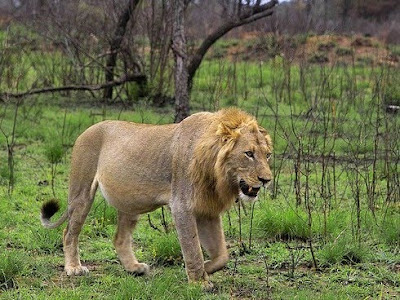Spring is in the air (well, maybe it's the pollen from the knob thorns), and the mongooses are abuzz with romance.
Achren - the alpha female in Ecthelion - is in oestrus.
How do I know? From the panic in the alpha male's eyes.
You think I'm kidding? I'm not. You see, dwarf mongooses are not fair and equitable when it comes to love. Only the group's upper echelons have a chance of scoring, and the alpha pair monopolises most of the action. Old Merriman (Ecthelion's battle-scarred alpha) will sire around 80% of all baby Ecthelions. But it's not an easy job.
During the 3-4 days that Achren is in heat, Merriman will guard her constantly. He trots along, just inches from her side, obsessively scanning the group for rivals while she calmly forages. If any male dares to venture within a couple of feet, Merriman lunges viciously, sending the intruder fleeing amid a chorus of submissive squeaking. Of course supremacy comes at a price. Each time Merriman tries to dig up a bug, Achren (named after a beautiful but wicked enchantress in Lloyd Alexander's Prydain series) casually strolls on. Merriman's torment is obvious as he momentarily vacillates between pursuing the juicy larvae and escorting his true love. Love wins every time.
Merriman (named after the Old One, Great Uncle Merry, in Susan Cooper's 'The Dark is Rising' series) enjoying the fruits of his diligence.
As you can imagine, by the end of the oestrus period, alpha males look gaunt and haggard. Their fur stares and you can almost see the dark rings under their eyes. Perhaps this is why they throw in the towel. On about the fourth day, they simply let the second-in-charge male take over. By the fifth day, it's the third male that's escorting her, and so on down the hierarchy. Even the little nine-month-old males will eventually indulge in a bit of hanky-panky with Mum. Is this how she guarantees that everyone helps raise her pups? 'This one is yours, dear.' Lucky they haven't figured out how to do DNA testing...
But despite Merriman's best efforts, every ten minutes or so, he loses sight of Achren entirely. I feel like shouting "Don't panic", but it's to no avail. Merriman races about the group frantically, peering over and around group members, searching behind bushes and rocks, and calling with rising hysteria. Achren completely ignores this show of ardour and continues to forage unperturbed. Although it seems absurd, Merriman's panic is not without cause: he's not the only one tracking Achren's movement. The moment she's unattended, Merlin (the deputy alpha) comes racing from across the group to hurl himself on top of her. She just glances irritably at him over her shoulder and goes on scratching through the leaf litter. If she's interested in mating, she'll slink quietly away from the group, trailing him behind, his nose glued to her tail.
As you can imagine, by the end of the oestrus period, alpha males look gaunt and haggard. Their fur stares and you can almost see the dark rings under their eyes. Perhaps this is why they throw in the towel. On about the fourth day, they simply let the second-in-charge male take over. By the fifth day, it's the third male that's escorting her, and so on down the hierarchy. Even the little nine-month-old males will eventually indulge in a bit of hanky-panky with Mum. Is this how she guarantees that everyone helps raise her pups? 'This one is yours, dear.' Lucky they haven't figured out how to do DNA testing...
Alpha females are not backward in coming forward. Jasmine, Halycon's reigning monarch, invites passersby to sniff the goods.




























